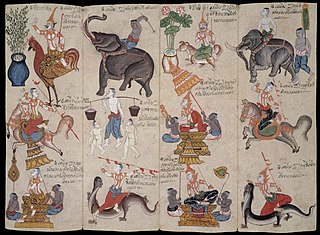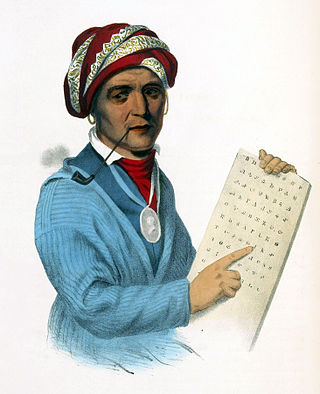
The full moon is the lunar phase when the Moon appears fully illuminated from Earth's perspective. This occurs when Earth is located between the Sun and the Moon. This means that the lunar hemisphere facing Earth—the near side—is completely sunlit and appears as an approximately circular disk. The full moon occurs roughly once a month.

The Hebrew calendar, also called the Jewish calendar, is a lunisolar calendar used today for Jewish religious observance and as an official calendar of Israel. It determines the dates for Jewish holidays and the appropriate public reading of Torah portions, yahrzeits, and daily Psalm readings, among many ceremonial uses. In Israel, it is used for religious purposes, provides a time frame for agriculture, and is an official calendar for civil holidays alongside the Gregorian calendar.

The Hijri calendar, also known in English as the Muslim calendar and Islamic calendar, is a lunar calendar consisting of 12 lunar months in a year of 354 or 355 days. It is used to determine the proper days of Islamic holidays and rituals, such as the annual fasting and the annual season for the great pilgrimage. In almost all countries where the predominant religion is Islam, the civil calendar is the Gregorian calendar, with Syriac month-names used in the Levant and Mesopotamia but the religious calendar is the Hijri one.
Intercalation or embolism in timekeeping is the insertion of a leap day, week, or month into some calendar years to make the calendar follow the seasons or moon phases. Lunisolar calendars may require intercalations of both days and months.

Concerning the lunar month of approximately 29.53 days as viewed from Earth, the lunar phase or Moon phase is the shape of the Moon's directly sunlit portion, which can be expressed quantitatively using areas or angles, or described qualitatively using the terminology of the four major phases and four minor phases.
A moveable feast is an observance in a Christian liturgical calendar which occurs on different dates in different years.

The Roman calendar was the calendar used by the Roman Kingdom and Roman Republic. Although the term is primarily used for Rome's pre-Julian calendars, it is often used inclusively of the Julian calendar established by the reforms of the dictator Julius Caesar and emperor Augustus in the late 1st century BC.

The Thai lunar calendar, or Tai calendar, is a lunisolar Buddhist calendar. It is used for calculating lunar-regulated holy days. Based on the SuriyaYatra, with likely influence from the traditional Hindu Surya Siddhanta, it has its own unique structure that does not require the Surya Siddhanta to calculate. Lunisolar calendars combine lunar and solar calendars for a nominal year of 12 months. An extra day or an extra 30-day month is intercalated at irregular intervals.

As a moveable feast, the date of Easter is determined in each year through a calculation known as computus. Easter is celebrated on the first Sunday after the Paschal full moon, which is the first full moon on or after 21 March. Determining this date in advance requires a correlation between the lunar months and the solar year, while also accounting for the month, date, and weekday of the Julian or Gregorian calendar. The complexity of the algorithm arises because of the desire to associate the date of Easter with the date of the Jewish feast of Passover which, Christians believe, is when Jesus was crucified.

Lunar New Year is the first new moon of a lunar calendar or lunisolar calendar year, whose months are moon cycles. The event is celebrated by numerous cultures in various ways at diverse dates.

The traditional Korean calendar or Dangun calendar is a lunisolar calendar. Dates are calculated from Korea's meridian, and observances and festivals are based in Korean culture.

Cherokee or Tsalagi is an endangered-to-moribund Iroquoian language and the native language of the Cherokee people. Ethnologue states that there were 1,520 Cherokee speakers out of 376,000 Cherokee in 2018, while a tally by the three Cherokee tribes in 2019 recorded ~2,100 speakers. The number of speakers is in decline. The Tahlequah Daily Press reported in 2019 that most speakers are elderly, about eight fluent speakers die each month, and that only 5 of people under the age of 50 are fluent. The dialect of Cherokee in Oklahoma is "definitely endangered", and the one in North Carolina is "severely endangered" according to UNESCO. The Lower dialect, formerly spoken on the South Carolina–Georgia border, has been extinct since about 1900. The dire situation regarding the future of the two remaining dialects prompted the Tri-Council of Cherokee tribes to declare a state of emergency in June 2019, with a call to enhance revitalization efforts.

Sequoyah, also known as George Gist or George Guess, was a Native American polymath and neographer of the Cherokee Nation. In 1821, he completed his independent creation of the Cherokee syllabary, making reading and writing in Cherokee possible. His achievement was one of the few times in recorded history that an individual who was a member of a pre-literate group created an original, effective writing system. His creation of the syllabary allowed the Cherokee nation to be one of the first North American Indigenous groups to have a written language. Sequoyah was also an important representative for the Cherokee nation, by going to Washington, D.C. to sign two relocations and trading of land treaties.

The Cherokee syllabary is a syllabary invented by Sequoyah in the late 1810s and early 1820s to write the Cherokee language. His creation of the syllabary is particularly noteworthy as he was illiterate until its creation. He first experimented with logograms, but his system later developed into the syllabary. In his system, each symbol represents a syllable rather than a single phoneme; the 85 characters provide a suitable method for writing Cherokee. Although some symbols resemble Latin, Greek, Cyrillic, and Glagolitic letters, they are not used to represent the same sounds.
The Hijri year or era is the era used in the Islamic lunar calendar. It begins its count from the Islamic New Year in which Muhammad and his followers migrated from Mecca to Yathrib in 622 CE. This event, known as the Hijrah, is commemorated in Islam for its role in the founding of the first Muslim community (ummah).

The Keetoowah Nighthawk Society was a Cherokee organisation formed ca. 1900 that intended to preserve and practice traditional "old ways" of tribal life, based on religious nationalism. It was led by Redbird Smith, a Cherokee National Council and original Keetoowah Society member. It formed in the Indian Territory that was superseded by admission of Oklahoma as a state, during the late-nineteenth century period when the federal government was breaking up tribal governments and communal lands under the Dawes Act and Curtis Act. The Nighthawks arose in response to weakening resolve on the part of Cherokee leaders—including the original Keetoowah Society, a political organization created by Cherokee Native American full bloods, in or about 1859—to continue their resistance on behalf of the Cherokee after the Dawes Commission began forcing the transfer of Oklahoma tribal lands in the Indian Territory to individual ownership in the 1890s.

Kituwa or giduwa (Cherokee:ᎩᏚᏩ) is an ancient Native American settlement near the upper Tuckasegee River, and is claimed by the Cherokee people as their original town. An earthwork platform mound, built about 1000 CE, marks a ceremonial site here. The historic Cherokee built a townhouse on top that was used for their communal gatherings and decisionmaking; they replaced it repeatedly over decades. They identify Kituwa as one of the "seven mother towns" in their traditional homeland of the American Southeast. This site is in modern Swain County, North Carolina, in the Great Smoky Mountains.
The Cham calendar is a lunisolar calendar used by the Cham people of Vietnam since ancient times. Its origins is based on Saka Raja calendar which was influenced by the Shaka era Indian Hindu calendar, with the current standard called Sakawi Cham likely instituted during the reign of Po Rome of the Champa kingdom.

In lunar calendars, a lunar month is the time between two successive syzygies of the same type: new moons or full moons. The precise definition varies, especially for the beginning of the month.
The New Kituwah Academy, also known as the Atse Kituwah Academy, is a private bilingual Cherokee- and English-language immersion school for Cherokee students in kindergarten through sixth grade, located in Cherokee, North Carolina, in the Yellow Hill community of the Qualla Boundary. It is owned by the Eastern Band of Cherokee Indians (EBCI), and operated by the Kituwah Preservation and Education Program (KPEP).















